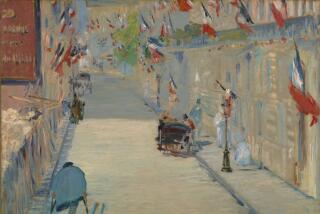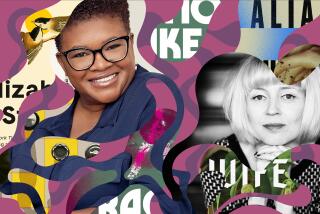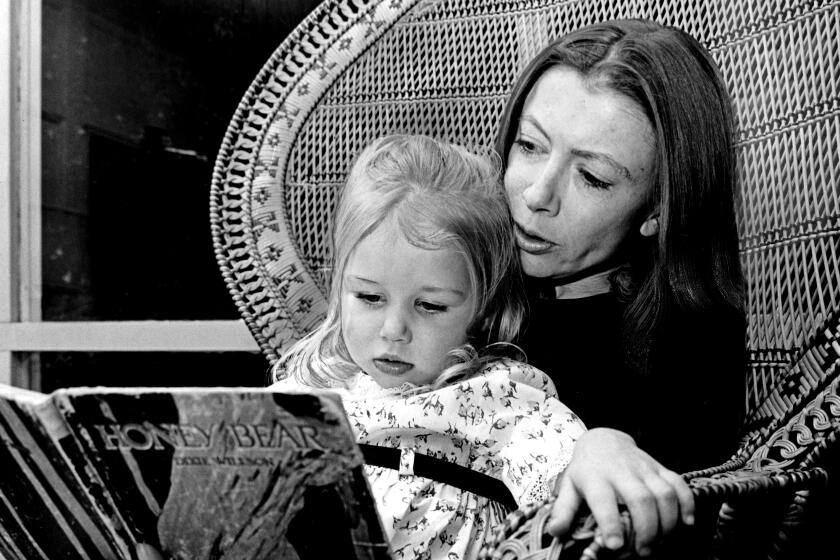Postcards from the edge
- Share via
A man pulls handfuls of handsome postcards from an old box and lays them out for a viewer, more or less in chronological order, musing and commenting. Who is the viewer? You. Probably, you too spend your summers in the Hamptons and share with your host an affectionate belief that fish-shaped Long Island is skinny enough to hug. And you, too, are on a first-name basis with the two centuries of artists and scenery depicted on his postcards -- you already know Amagansett and Sag Harbor, and who Patsy is, and Jane, and Elaine, not to speak of Bill, Jackson, Frank and Saul.
On the other hand, everybody knows who they are, so maybe you would take an interest in this display, whoever you are, just because their pictures are in it.
“De Kooning’s Bicycle” is this sort of book: not history, exactly, and not memoir or portraiture, but a kind of celebrity scrapbook. Poet Robert Long is the art critic for the East Hampton Star: He began visiting the east end of Long Island regularly in the early 1960s, when his family would occupy an unheated cottage in the hamlet of Springs, “just down the road from the places where Jackson Pollock died, Frank O’Hara drank gimlets, Jean Stafford stared out her study window, and Willem de Kooning rode his Royce Union three-speed, white hair and work shirt flapping.”
These artists had been moving into the Hamptons since the 1940s but were not yet legends when Long became their neighbor. Now all of them are famous, and dead, and Long has an insider’s access to their stories. Better yet, he has a poet’s instinct for the way to bring them back to life, on a thumbnail.
The book is divided into two parts: a brief historical overview of the settlement of Long Island by English colonists in the 17th century, its discovery by painters in the 19th century; then a series of chapters on those charismatic artists who began endowing the Hamptons with their glamour in the middle of the 20th century.
Writing historical narrative does not come easily to Long. He seems oblivious to the organizing helpfulness of chronology, and his absent-mindedness produces jarring effects as he swerves unmethodically through his research notes. Many of the chapters also have unexplained dates attached to them in parentheses, as though the book had been compiled from earlier sources or diaries.
But Long’s most effective establishing shots are topographical rather than historical, anyway. He lavishes attention on the way light falls on this narrow landmass, where water is hardly ever out of sight. It is the distinctive light of Long Island, rising off the water, that drew artists to these locales in the first place -- that, and the low cost of living and the presence of the wealthy summer folk who became the artists’ patrons. “Small town attitudes and big city money were found side by side” in the Hamptons by the time the artists began to arrive.
As the title suggests, Long is most interested in the big-name, well-paid artists who left a legacy of anecdote that he can plunder. Most of his material is not new. It began appearing in print as long ago as 1972, in John Gruen’s lively memoir, “The Party’s Over Now: Reminiscences of the Fifties -- New York’s Artists, Writers, Musicians and Their Friends.” (Gruen’s photograph of O’Hara appears in “De Kooning’s Bicycle.”)
But Long’s approach to this familiar lore -- a daring act of ventriloquism -- resembles nothing else in print. He writes from inside the artists’ heads, imagining thoughts and feelings that might have accompanied their familiar habits and notorious antics.
Long almost always begins a chapter inside the stream of consciousness of an anonymous “he” or “she” and leaves the reader wondering who, where and why, until, several pages later, a photograph reveals the answer. The poet O’Hara in the sculpture garden at the Museum of Modern Art, and, later, with his back to a tree in Southampton. Alfonso Ossorio in his junk-filled studio (that was a hard one to guess). Stafford in a director’s chair on the lawn, wearing a Coca-Cola logo on her sweatshirt and laced-up tennis shoes imprinted with stars. The poet James Schuyler, perched boyishly at a breakfast table with his indulgent hostess, Anne Porter, and her husband, the painter Fairfield Porter, who was Schuyler’s lover.
The photos are valuable attractants in “De Kooning’s Bicycle,” but the book will stand or fall on its storytelling. In the most audacious chapter, Long writes a monologue for the ghost of Jackson Pollock, who comes back to New York from the grave to visit his painting “Autumn Rhythm” at the Met. The story carries us from this opening fantasy back into the real past: Pollock’s first days at his farmhouse near Springs, clearing out the barn to make a studio; how it felt to make a painting; how he’d met his wife, Lee Krasner; scenes from the marriage. Long’s revisitation of Pollock’s life ends with a verbal postcard: Jackson in action, color looping from his brush onto a very big, empty canvas.
None of the stories in this book is boring, but the most satisfactory writing appears in the last chapter, which begins with Saul Steinberg settling into breakfast at a diner on the outskirts of Southampton. Long had the advantage of reading Steinberg’s conversations with a fellow bon vivant, the writer Aldo Buzzi, printed in “Reflections and Shadows.” The interior monologue Long creates for Steinberg manages to suggest the thought processes of a man whose first language was not English and whose whole mental life was devoted to defamiliarizing the real world. It ends with Steinberg in a deck chair, at evening, gazing at the scenery from his dooryard: the right ending for a book that has shown us what a diverting occupation it can be, just musing on the subjects that appear on postcards. *
More to Read
Sign up for our Book Club newsletter
Get the latest news, events and more from the Los Angeles Times Book Club, and help us get L.A. reading and talking.
You may occasionally receive promotional content from the Los Angeles Times.








